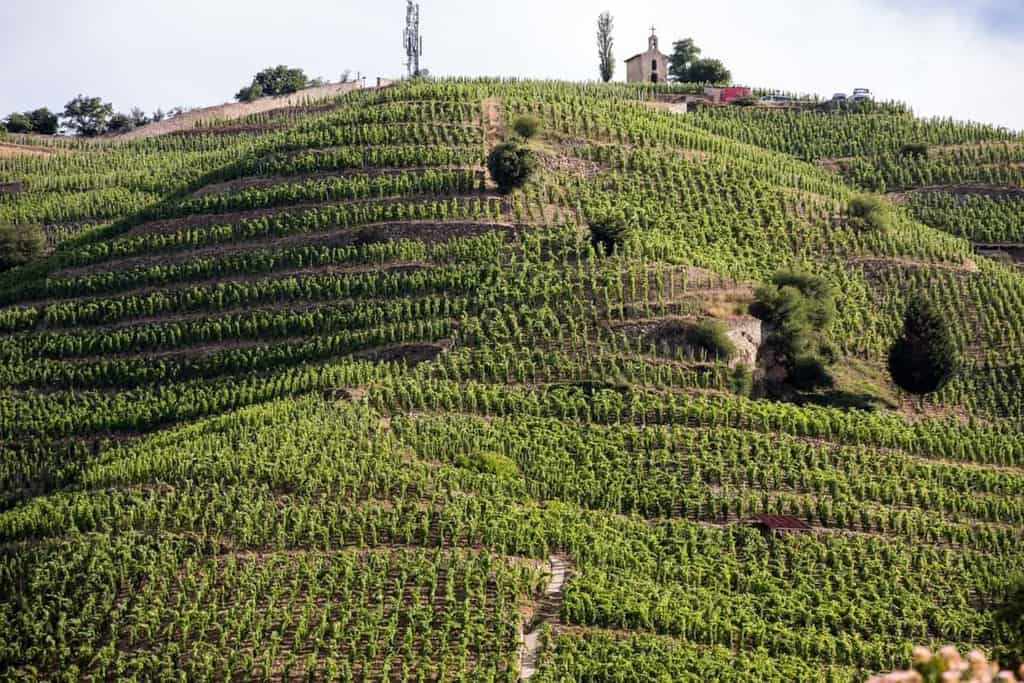Last Updated on August 23, 2019.
Marsanne Grape Variety & Wine Profile
Marsanne is believed to originally be from the Rhône Valley, where it still thrives. Often blended with Roussanne, Viognier, Clairette and other varieties found throughout Southern France, it produces a weighty wine that can stand up to a broad range of dishes.
RELATED: Learn About France’s Rhone Valley Wine Region
On the nose, expect oranges, sweet lemon, figs, apricot, pear, and almond notes. On the palate, its rich texture elicits beeswax, roasted nuts, pears, Meyer lemon, cardamom and anise. Marsanne can produce a fairly decadent wine because its weight begs to be paired with seafood, cream-based dishes, and other luxurious meals. Marsanne and Marsanne-blends can often replace Chardonnay for those who would like to expand their palates and try something different.
Although not as commonly found, Marsanne can also be used to produce sweet wine. For this, the grapes are dried out first on straw mats, which allows them to dry enough to concentrate sugar. However, these can lack acidity and therefore tend not to be quite as sought-after as dessert wines produced from high-acid varieties.
Due to the delicate balance of acidity and ripeness, Marsanne has a rather small window for harvest. If it’s left too long, acidity drops and the wines can come across as flabby. When harvested at the perfect moment, however, Marsannes are lush, layered, and delicious.
Wine Growing Regions for Marsanne
Marsanne shines brightest in the Northern Rhône, and particularly in Hermitage. However, it can also be found all throughout the Southern Rhône, Languedoc-Roussillon, and Provence where it is typically blended with a huge range of other varieties. Wines from these regions tend not to be as expressively specific as single-varietal bottlings of Marsanne.
The Central Coast of California has become home to many Marsanne producers, thanks in part to Tablas Creek’s efforts to spread the gospel of Rhône wines. Even throughout this “Rhône Ranger” territory, it is often blended with Roussanne, Viognier, and Grenache Blanc.
The Sierra Foothills AVA of California is another region to watch for Marsanne. Rhône varieties tend to love the huge diurnal swings and thrive. It can also be found in smatterings throughout Sonoma and Napa.
Other regions, like Australia, are producing more white Rhône blends, but not single-varietal bottlings of Marsanne just yet. That said, these delicious blends stand on their own and show how crucial Marsanne is to the flavor profile.
Check out some of these Marsanne and Marsanne-based blends from around the world:
- Jean-Louis Chave, Hermitage, France
- Chapoutier “Chante Alouette”, Hermitage, France
- Guigal “Lieu-Dit”, Saint-Joseph, France
- Tablas Creek “Cotes de Tablas Blanc”, Adelaida District, Paso Robles, California
- Qupé, Santa Ynez Valley, Santa Barbara County, California
- John Duval “Plexus White”, Barossa, Australia
- B Minor Marsanne Rousanne, Yarra Valley, Victoria, Australia
Learn About These Other Wine Grape Varieties
Written By Jamie Metzgar
Jamie Elizabeth Metzgar began her career in wine by pouring in a tasting room on the East End of Long Island, NY. After moving to New York City, she landed a position at Chambers Street Wines where she was encouraged to pursue wine education at the Wine & Spirits Education Trust (WSET). She earned Level III certification there and has since earned California Wine Appellation Specialist and Certified Specialist of Wine certifications as well. After way too many moves, she has recently landed in Northern California where she is compiling an unofficial roster of dog-friendly tasting rooms.
Marsanne Tasting Notes
Fruit: Oranges, Sweet lemon, Figs, Apricot, Pear and Almond
Earth & Additional Nuances: Beeswax, Roasted Nuts, Cardamon, Anise
The Structure and Style of Marsanne Wines
Body Medium - Full
Sugar Dry (Primarily) Occasionally vinified Sweet.
Acid Medium
Alcohol High (13 - 15%)
